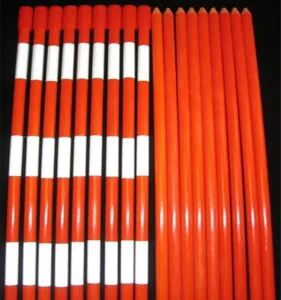Introduction
Driveway markers serve as silent guardians of your property, guiding your path during the darkest nights and the most challenging weather conditions. As seemingly simple as they are, choosing the right type of driveway marker—fiberglass or traditional—can significantly impact their effectiveness and durability. This guide offers a deep dive into the world of driveway markers, comparing the modern fiberglass variants with their traditional counterparts to help you make the best choice for your driveway needs.

fiberglass driveway marker
The Evolution of Driveway Markers
Originally, driveway markers were rudimentary, crafted from readily available materials like wood. Over time, the quest for more durable, visible, and weather-resistant markers led to the adoption of metals and plastics. The rise of fiberglass technology marked a significant turning point, offering a blend of durability, flexibility, and visibility that challenged the status quo of driveway marker materials.
Understanding Fiberglass Driveway Markers
Fiberglass driveway markers are renowned for their exceptional strength-to-weight ratio, resistance to corrosion, and flexibility. These markers are made from fine glass fibers woven into a fabric, then coated with a resin to form a lightweight yet robust marker.
Advantages of fiberglass markers include their remarkable durability, minimal maintenance requirements, and resistance to weather elements, making them ideal for regions prone to severe weather conditions. However, potential drawbacks might include a higher upfront cost compared to some traditional materials and limited customization options in terms of aesthetics.
Exploring Traditional Driveway Markers
Traditional driveway markers have been made from a variety of materials, including wood, metal, and plastic. Each material brings its own set of benefits and limitations to the table.
- Wood markers offer a classic aesthetic and natural biodegradability but can rot or break easily.
- Metal markers are sturdy and can provide a sleek look but may rust over time.
- Plastic markers are lightweight and affordable but can become brittle and crack in cold temperatures.
Comparative Analysis: Fiberglass vs. Traditional
When comparing fiberglass to traditional driveway markers, several key factors emerge:
- Durability and Lifespan: Fiberglass markers typically outlast their traditional counterparts, offering better long-term value.
- Visibility in Various Conditions: Many fiberglass markers are designed with enhanced visibility features, such as reflective tapes, which are crucial for safety during night-time and snowy conditions.
- Environmental Impact: Fiberglass markers, while durable, are not biodegradable, whereas some traditional materials, like wood, offer a more eco-friendly disposal option.
- Installation and Maintenance: Fiberglass markers are generally easier to install and require less maintenance over their lifespan compared to traditional markers.
- Cost Comparison: Initial investment in fiberglass markers may be higher, but their longevity and minimal maintenance can make them more cost-effective in the long run.
The Role of Driveway Markers in Safety and Navigation
Driveway markers are pivotal in enhancing nighttime visibility and ensuring safe navigation into and out of driveways. They play a crucial role in snow removal, marking the boundaries of a driveway to prevent accidental damage to the landscape or driveway surface.
Innovations in Driveway Marker Technology
The driveway marker industry continues to evolve, with LED and solar-powered options offering enhanced visibility and energy efficiency. Smart markers, equipped with IoT technology, represent the frontier in driveway marker innovation, providing functionalities like automatic lighting and communication with smart home systems.
Consumer Guide: Choosing the Right Driveway Markers
Choosing the right driveway marker involves considering several factors, such as the climate of your area, the length and material of your driveway, and your specific visibility needs. Installation is typically straightforward, but the alignment and spacing of markers are key to ensuring effectiveness.
Real-Life Experiences: Testimonials and Case Studies
Homeowners and professionals alike share their experiences with both fiberglass and traditional driveway markers. These real-life insights can provide valuable guidance in making an informed decision.
Fiberglass vs. Traditional Driveway Markers: Making the Best Choice
In conclusion, both fiberglass and traditional driveway markers have their place, depending on individual needs and preferences. Fiberglass markers offer a modern, durable, and low-maintenance solution, while traditional materials may appeal to those with specific aesthetic preferences or environmental considerations.
Conclusion
Choosing the right driveway markers is more than a matter of preference; it’s a decision that impacts the safety, aesthetics, and maintenance of your property. By understanding the unique benefits and limitations of fiberglass versus traditional driveway markers, you can select the best option to meet your needs, ensuring a well-marked driveway for years to come.
 info@unicomposite.com
info@unicomposite.com


























